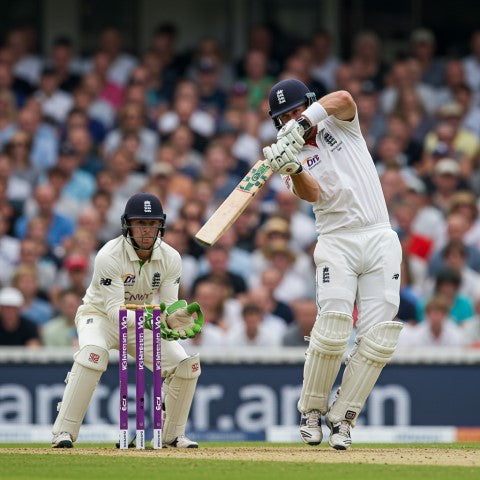What Is the Ranji Trophy? India’s Red-Ball Powerhouse

In a cricketing nation obsessed with white-ball fireworks and IPL fanfare, one tournament has stood firm as the bedrock of India’s red-ball cricket tradition: the Ranji Trophy. Quietly running in the background while cameras chase T20 sixes, this first-class domestic championship has been shaping India’s Test side for nearly a century.
Named after the iconic cricketer Kumar Shri Ranjitsinhji — India’s first global cricketing figure — the tournament began in 1934 with a singular mission: to develop India’s regional cricketing depth and provide a pathway to the national team. Today, it remains the country’s premier red-ball competition, featuring state teams and regional heavyweights vying not just for silverware, but for selection, prestige, and legacy.
It’s the competition where legends are made — from Sunil Gavaskar and Sachin Tendulkar to Cheteshwar Pujara and Ravichandran Ashwin. For aspiring Indian cricketers, a strong Ranji season is still the golden ticket to Test contention.
Yet the Ranji Trophy exists in a paradox. It’s foundational, yet under-publicised. It produces stars, but rarely headlines. In the age of glittering leagues and franchise followings, why does it still matter?
Let’s explore the history, format, rivalries, and relevance of India’s red-ball powerhouse — the Ranji Trophy.
1. The Origins of the Ranji Trophy: Honouring a Cricketing Pioneer
The story of the Ranji Trophy begins not on Indian soil, but in England. Kumar Shri Ranjitsinhji, the Jam Sahib of Nawanagar, made waves playing for England in the late 19th century. A stylistic enigma, he was the first Indian-born cricketer to achieve global fame — revered for his leg-side elegance and unorthodox technique.
When India sought to launch a national cricket championship in 1934, it was fitting that it be named in his honour. The trophy was conceived to unify India’s fragmented domestic structure and give players across the subcontinent a competitive platform. What began with 15 teams has now evolved into a multi-tiered competition featuring over 35 sides, reflecting India's diverse cricketing geography.
In the early years, teams represented princely states, clubs, and associations. Bombay (now Mumbai) dominated the formative decades, winning title after title and establishing itself as Indian cricket’s beating heart. The format was knockout-based initially but later transitioned into league and group systems to allow more matches — and thus, more opportunities.
Crucially, the Ranji Trophy wasn’t just about silverware. It was about Test selection. If you wanted to wear the India cap, you had to first prove yourself here. The ethos was simple: earn it with the red ball.
Nearly 90 years on, that principle still holds — and the Ranji Trophy remains the purest meritocracy in Indian cricket.
2. Format and Structure: How the Tournament Works Today
The Ranji Trophy has evolved dramatically from its early knockout format. Today, it functions as a sprawling, multi-tiered competition that spans months — and kilometres. With 38 teams spread across four groups, the structure is designed to be both competitive and inclusive, covering established cricketing centres and developing regions alike.
Teams are divided into Elite and Plate groups based on performance. The Elite group comprises the stronger sides, typically traditional powerhouses like Mumbai, Karnataka, and Delhi. The Plate group includes newer entrants such as Meghalaya, Nagaland, and Mizoram — part of the BCCI’s wider domestic cricket development strategy.
Each team plays a set number of matches in the group stage, with points awarded for wins, draws (based on first-innings lead), and outright results. The top teams then progress to knockout rounds, culminating in a semi-final and final played under strict first-class conditions.
Matches are played over four days in the league stage and five days in the final, adhering closely to Test match formats — including red balls, white clothing, and two innings per side. This structure offers vital preparation for players aiming to succeed at international level.
One of the format’s strengths is the variety it demands: seaming pitches in the north, turning tracks in the south, slow outfields in the northeast. Players must adapt constantly — a skill central to succeeding in India’s Test side.
For all the excitement of T20 cricket, the structure and discipline of the Ranji Trophy remains unmatched in its contribution to India’s red-ball depth.
3. A Breeding Ground for Indian Test Talent
If Indian cricket were a factory, the Ranji Trophy would be its most productive assembly line. Every era of India’s Test side — from the spin quartet of the ’70s to the pace arsenal of the 2020s — has been forged in Ranji battles.
Rahul Dravid’s technique? Sharpened in Ranji. Pujara’s patience? Moulded in Saurashtra. Ravindra Jadeja’s all-round prowess? Refined on domestic wickets. Even modern quicks like Mohammed Siraj and Umesh Yadav found their rhythm bowling long spells in tough Ranji conditions, far from the glare of the IPL.
The tournament exposes players to the rigours of red-ball cricket — batting for hours, bowling with old balls, facing tricky conditions, and building innings from the ground up. It rewards grit and punishes shortcuts. And unlike limited-overs cricket, there’s no hiding — every mistake is amplified.
What also makes the Ranji Trophy invaluable is the volume of cricket. Players can build form across weeks, recover from failures, and prove consistency — something no T20 league allows. Selectors still consider Ranji performances essential when evaluating Test readiness.
That’s why the tournament remains central to India’s red-ball pipeline. For every Virat Kohli lighting up an IPL, there’s a Hanuma Vihari grinding out a 180 in a half-empty stadium in Indore — and that matters.
Even today, if you want to wear the whites for India, you prove it in the Ranji Trophy.
4. Regional Pride: The Rivalries That Define the Ranji Trophy
While the IPL thrives on star power and franchise drama, the Ranji Trophy is driven by something more enduring — regional pride. These aren't city brands with glossy marketing; they’re state teams that represent generations of tradition and territorial legacy.
Take Mumbai vs Delhi — two titans of Indian cricket, both with a fierce sense of history. Mumbai’s legacy of 41 titles is unmatched, but Delhi has always fancied itself the disruptor, producing fiery talents like Virender Sehwag and Gautam Gambhir. When they clash in the Ranji Trophy, it’s more than a fixture — it’s a statement.
Down south, Karnataka and Tamil Nadu contests are routinely intense. It’s not just cricket — it's a cultural edge. These games are closely fought, and careers have been defined by performances in them. You’ll hear local coaches, even years later, reference “that 90 against TN under pressure” like it’s folklore.
And then there’s the newer pride: Saurashtra rising as a red-ball force. Vidarbha winning back-to-back titles. Plate Group teams from the northeast pushing into knockout stages. These narratives don't always grab headlines — but they shake the system from within.
In a country as diverse as India, regional cricket is a microcosm of national identity. And in that landscape, the Ranji Trophy still delivers the most honest, high-stakes rivalries Indian cricket can offer.
5. Record-Breakers and Legendary Performances
The Ranji Trophy may not always command prime-time attention, but its scorebooks are filled with numbers that astonish. Records here aren’t just statistics — they’re career milestones and moments that shape selection debates for years.
Let’s start with B. B. Nimbalkar’s unbeaten 443 for Maharashtra in 1948 — the highest individual score in Ranji history. It’s a mark that has stood for over seven decades, surviving the arrival of flat pitches and fearless batters.
What about bowlers? Rajinder Goel, who never played a Test for India, took an extraordinary 637 Ranji wickets. Narendra Hirwani, Bishan Bedi, and Ashutosh Aman all left significant legacies with the ball. Their mastery in domestic conditions made them feared, respected, and sometimes criminally underrated.
Then there are the standout seasons — like Wasim Jaffer’s 1,260 runs in 2008–09 or Jaydev Unadkat’s 67 wickets in 2019–20, leading Saurashtra to their maiden title. These weren’t one-off knocks or flukes — they were red-ball marathons that proved pedigree.
And perhaps most impressively, the Ranji Trophy has been the launchpad for records that carried into the international arena. Tendulkar’s precocious debut, Dravid’s early dominance, Pujara’s reliability — they all began with match-defining performances in these state-level trenches.
In a cricket culture obsessed with sixes and strike rates, the Ranji Trophy remains the guardian of substance. The place where endurance trumps flair, and records are forged over sessions, not just overs.
6. The Role of the Ranji Trophy in India’s Domestic Ecosystem
In the complex machinery of Indian cricket, the Ranji Trophy is the engine. Not the glitziest part — but certainly the most important. Without it, the system would collapse.
It’s the competition that connects grassroots cricket with the national team. District-level performers rise through age-group and inter-state tournaments to reach Ranji level — and from there, the national spotlight. It ensures a continuous pipeline, not just for the Indian XI, but for India A, the Duleep Trophy, and even IPL franchises scouting for red-ball credentials.
More than just a talent pool, the Ranji Trophy also sustains the ecosystem financially and structurally. It provides match fees, travel allowances, and contracts for hundreds of domestic cricketers who may never play for India but make a full-time living from the game. Coaches, physios, curators, analysts, scorers, and support staff are also paid professionals because of this tournament.
It also keeps red-ball cricket alive in a country rapidly seduced by T20. Without Ranji, young cricketers wouldn’t learn the skills necessary to bat long, bowl into the wind, or plan dismissals over extended spells. These are Test-match traits — and they don’t develop under floodlights in 20-over matches.
The BCCI, for all its focus on commercial T20 properties, continues to invest heavily in the Ranji Trophy. Venues are maintained, travel and lodging are subsidised, and media coverage is slowly improving. That commitment reflects its ongoing importance.
For India to remain a red-ball powerhouse — and continue producing players with temperament, technique, and toughness — the Ranji Trophy must remain not just relevant, but essential.
7. Challenges in the Modern Era: Relevance, Visibility & Scheduling
Despite its pedigree, the Ranji Trophy faces serious challenges in today’s cricketing landscape. While the tournament remains critical to India’s red-ball structure, it battles for attention in a world that increasingly values brevity, branding, and broadcast appeal.
The first issue is visibility. Ranji matches are rarely televised. Even when they are, the coverage is limited to major knockout rounds. In an age where even age-group T20 games are live-streamed, this lack of exposure is telling. Players scoring double hundreds or taking 10-wicket hauls often go unnoticed outside of stat sheets and selectors’ reports.
Second is scheduling. The competition often gets relegated in importance to accommodate IPL windows, international tours, and other domestic tournaments. Weather interruptions, poor pitch quality at some venues, and logistical headaches across the vast Indian map can affect the quality of cricket and preparation.
Then there’s the format’s general appeal — or lack thereof. Long-format cricket, while essential for Test readiness, struggles to attract stadium crowds. Barring finals or major derbies, most games are played in near silence, with a handful of supporters watching from shaded stands or boundary ropes.
Additionally, young players are understandably drawn to the glamour and money of T20. If they can earn more in a three-week franchise league than they can in a full Ranji season, the motivation balance becomes lopsided.
The Ranji Trophy isn’t obsolete — far from it. But it does need reform. Better coverage, improved facilities, and a reimagined incentive model could go a long way in keeping it relevant for players and compelling for fans.
8. Why the Ranji Trophy Still Matters in the Age of T20
It’s easy to dismiss the Ranji Trophy as a relic in the age of sixes and salary caps. But that would be a mistake — and a dangerous one for Indian cricket’s long-term health.
Here’s why it matters: Test cricket still defines greatness. Every cricketer who dreams of a lasting legacy doesn’t just want to play for India — they want to play five-day cricket in whites, in front of a packed Lord’s or Eden Gardens. And to get there, the Ranji Trophy remains the essential proving ground.
Unlike T20s, where form can be fleeting and match-ups fleetingly exploited, red-ball cricket demands temperament. It tests a player’s technique, mental stamina, and adaptability over sessions, not overs. There’s no hiding from poor form — or flat pitches.
Also, the Ranji Trophy creates volume. Across the span of a season, a batter might face high-quality spin in Chennai, swing in Mohali, or sharp pace in Nagpur. That variety prepares them for the diversity of conditions in international cricket — something no franchise tournament can replicate.
Culturally, the Ranji Trophy matters because it decentralises the sport. Not every hero comes from Mumbai or Delhi. Saurashtra, Vidarbha, Himachal Pradesh — the system creates stories from every corner of India. That richness is its strength.
In short, the Ranji Trophy isn’t just a tournament. It’s the last remaining battleground where real red-ball skills are born — and where the next generation of Test cricketers are quietly forged.
Conclusion: The Ranji Trophy — India’s Forgotten, Unshakeable Backbone
In the bright glare of the IPL and the endless churn of international cricket, the Ranji Trophy often feels like the sport’s quiet cousin — steadfast, serious, and mostly out of sight. But that quiet strength is precisely why it endures.
It has survived partition, financial crises, structural overhauls, and the digital age. It has shaped every Indian Test generation, from Gavaskar and Kapil to Kohli and Siraj. Its stadiums may be half-empty, but its scorecards are full of stories that define Indian cricket’s resilience.
Yes, it needs reform. Yes, it could use better marketing. But the core is intact. The hunger to perform. The weight of the cap. The badge of state honour. And the silent knowledge that if you can succeed in the Ranji grind, you belong at the highest level.
In an age obsessed with moments, the Ranji Trophy still believes in seasons. In sessions. In sustained excellence. And that’s what makes it irreplaceable — not just to selectors, but to the soul of Indian cricket.





Leave a comment